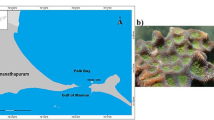Abstract
Twenty-nine marine bacterial strains were isolated from the sponge Hymeniacidon perleve at Nanji island, and antimicrobial screening showed that eight strains inhibited the growth of terrestrial microorganisms. The strain NJ6-3-1 with wide antimicrobial spectrum was identified as Pseudoalteromonas piscicida based on its 16S rRNA sequence analysis. The major antimicrobial metabolite, isolated through bioassay-guide fractionation of TLC bioautography overlay assay, was identified as norharman (a beta-carboline alkaloid) by EI-MS and NMR.
Similar content being viewed by others
References
H. Aassila M.L. Bourguet-Kondracki S. Rifai A. Fassouane M. Guyot (2003) ArticleTitleIdentification of harman as the antibiotic compound produced by a tunicate-associated bacterium Marine Biotechnology 5 163–166
S.G. Acinas J. Anton F. Rodriguez-Valera (1999) ArticleTitleDiversity of free-living and attached bacteria in offshore western Mediterranean waters as depicted by analysis of genes encoding 16s rRNA Applied and Environmental Microbiology 65 514–522
S. Agurell B. Holmstedt J.E. Lindgren R.E. Schultes (1968) ArticleTitleIdentification of two new beta-carboline alkaloids in South American hallucinogenic plants Biochemical Pharmacology 17 2487–2488
A. Al-Shamma S. Drake D.L. Flynn L.A. Mitscher Y.H. Park G.S. Rao A. Simpson J.K. Swayze T. Veysoglu S.T. Wu (1981) ArticleTitleAntimicrobial agents from higher plants. Antimicrobial agents from Peganum harmala seeds Natural Products 44 745–747
K.K. Ang M.J. Holmes T. Higa M.T. Hamann U.A. Kara (2000) ArticleTitleIn vivo antimalarial activity of the beta-carboline alkaloid manzamine A Antimicrobial Agents and Chemotherapy 44 1645–1649
E. Armstrong L. Yan K.G. Boyd P.C. Wright J.G. Burgess (2001) ArticleTitleThe symbiotic role of marine microbes on living surfaces Hydrobiologia 461 37–40 Occurrence Handle10.1023/A:1012756913566
C.A. Bewley D.J. Faulkner (1998) ArticleTitleLithistid sponges: star performers or hosts to the stars Angewandte Chemie-International Edition 37 2162–2178
J.G. Burgess E.M. Jordan M. Bregu A. Mearns-Spragg K.G. Boyd (1999) ArticleTitleMicrobial antagonism: a neglected avenue of natural products research Journal of Biotechnology 70 27–32
A.M. Burja R.T. Hill (2001) ArticleTitleMicrobial symbionts of the Australian Great Barrier Reef sponge, Candidaspongia flabellate Hydrobiologia 461 41–47
D.J. Faulkner (2002) ArticleTitleMarine natural products Natural Products Report 19 1–48
S. Gibbons A.I. Gray (1998) Isolation by polanar chromatography RJP Cannell (Eds) Natural Products Isolation Humana press Totowa, New Jersey 209–245
D.T. Harwood S. Urban J.W. Blunt M.H. Munro (2003) ArticleTitleBeta-carboline alkaloids from a New Zealand marine bryozoan, Cribricellina cribraria Natural Products Research 17 15–19
U. Hentschel M. Schmid M. Wagner L. Fieseler C. Gernert J. Hacker (2001) ArticleTitleIsolation and phylogenetic analysis of bacteria with antimicrobial activities from the Mediterranean sponges Aplysina aerophoba and Aplysina cavernicda FEMS Microbiology Ecology 35 305–312
U. Holler A.D. Wright G.F. Matthee G.M. Konig S. Draeger A. Hans-Jurgen B. Schulz (2000) ArticleTitleFungi from marine sponges: diversity, biological activity and secondary metabolites Mycological Research 104 1354–1365
E.P. Ivanova D.V. Nicolan N. Yumoto T. Taguchi K. Okamoto Y. Tatsu S. Yoshikawa (1998) ArticleTitleImpact of conditions of cultivation and adsorption on antimicrobial activity of marine bacteria Marine Biology 130 545–551
G.S. Jayatilake M.P. Thornton A.C. Leonard J.E. Grimwade B.J. Baker (1996) ArticleTitleMetabolites from an Antarctic sponge-associated bacterium, Pseudononas aeruginosa Journal of Natural Products 59 293–296
S. Kodani A. Imoto A. Mitsutani M. Murakami (2002) ArticleTitleIsolation and identification of the antialgal compound, harmane (1-methyl-β-carboline), produced by the algicidal bacterium, Pseudomonas sp. K44-1 Journal of Applied Phycology 14 109–114
A. Mearns-Spragg M. Bregu K.G. Boyd J.G. Burgess (1998) ArticleTitleCross-species induction and enhancement of antimicrobial activity produced by epibiotic bacteria from marine algae and invertebrates, after exposure to terrestrial bacteria Letters in Applied Microbiology 27 142–146
M. Mitova G. Tommonaro D.S. Rosa (2003) ArticleTitleA novel cyclopeptide from a bacterium associated with the marine sponge Ircinia muscarum Zeitschrift für Naturforschung 58 740–745
R. Osinga E. Armstrong G.J. Burgess F. Hoffmann J. Reitner G. Schumann-Kindel (2001) ArticleTitleSponge-microbe associations and their importance for sponge bioprocess engineering Hydrobiologia 461 55–62
G.R. Pettit J.P. Xu J.C. Chapuis R.K. Pettit L.P. Tackett D.L. Doubek J.N. Hooper J.M. Schmidt (2004) ArticleTitleAntineoplastic agents. 520. Isolation and structure of irciniastatins A and B from the Indo-Pacific marine sponge Ircinia ramosa Journal of Medicinal Chemistry 47 1149–1152
K.V. Rao B.D. Santarsiero A.D. Mesecar R.F. Schinazi B.L. Tekwani M.T. Hamann (2003) ArticleTitleNew manzamine alkaloids with activity against infectious and tropical parasitic diseases from an Indonesian sponge Journal of Natural Products 66 823–828
M.A. Rashid K.R. Gustafson M.R. Boyd (2001) ArticleTitleNew cytotoxic N-methylated beta-carboline alkaloids from the marine ascidian Eudistoma gilboverde Journal of Natural Products 64 1454–1456
D.L. Santavy P. Willenz R.R. Colwell (1990) ArticleTitlePhenotypic study of bacteria associated with the Caribbean sclerosponge, Ceratoporella nicholsoni Applied and Environmental Microbiology 56 1750–1762
R.N. Sonnenschein J.J. Farias K. Tenney S.L. Mooberry E. Lobkovsky J. Clardy P.A. Crews (2004) ArticleTitleFurther study of the cytotoxic constituents of a milnamide-producing sponge Organic Letters 6 779–782
F. Sponga L. Cavaletti A. Lazzarini A. Borghi I. Ciciliato D. Losi F. Marinelli (1999) ArticleTitleBiodiversity and potentials of marine-derived microorganisms Journal of Biotechnology 70 65–69
E.D. Strahl W.E. Dobson J.L.L. Lundie (2002) ArticleTitleIsolation and screening of brittlestar-associated bacteria for antibacterial activity Current Microbiology 44 450–459
K. Suzumura T. Yoko M. Funatsu K. Nagai K. Tanaka H. Zhang K. Suzuki (2003) ArticleTitleYM-266183 and YM-266184, novel thiopeptide antibiotics produced by Bacillus cereus isolated from a marine sponge II. Structure elucidation Journal of Antibiotics (Tokyo) 56 129–134
M.D. Unson D.J. Faulkner (1993) ArticleTitleCyanobacterial symbiont biosynthesis of chlorinated metabolites from Dysidea herbacea Experientia 49 349–353
M.D. Unson N.D. Holland D.J. Faulkner (1994) ArticleTitleA brominated secondary metabolite synthesized by the cyanobacterial symbiont of marine sponge and accumulation of the crystalline metabolite in the sponge tissue Marine Biology 119 1–11
C.R. Wilkinson (1978) ArticleTitleMicrobial association in sponges. II: numerical analysis of sponge and water bacterial populations Marine Biology 49 169–176
Author information
Authors and Affiliations
Corresponding author
Rights and permissions
About this article
Cite this article
Zheng, L., Chen, H., Han, X. et al. Antimicrobial screening and active compound isolation from marine bacterium NJ6-3-1 associated with the sponge Hymeniacidon perleve. World J Microbiol Biotechnol 21, 201–206 (2005). https://doi.org/10.1007/s11274-004-3318-6
Received:
Issue Date:
DOI: https://doi.org/10.1007/s11274-004-3318-6




